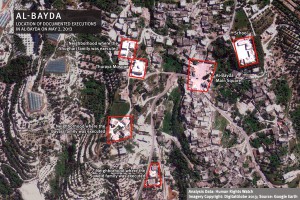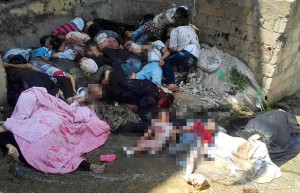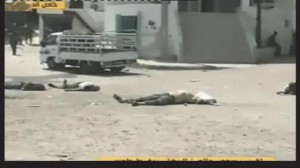 7. Sectarian cleansing?
7. Sectarian cleansing?
Although it is being thrown about too casually in the Syrian context, the term ‘ethnic cleansing’ or ‘sectarian cleansing’ has a strict legal definition. It usually refers to “a purposeful policy designed by one ethnic or religious group to remove by violent and terror-inspiring means the civilian population of another ethnic or religious group from certain geographic areas.”1
In other words, they refer to the mass displacement of civilian population from their homes, using coercive and unlawful means, with the intent of changing the ethnic or sectarian character of the area. The homes of the displaced are often destroyed so that they cannot return to them, and new population of another, rival ethnicity or sect usually settle in their place.
In addition to other crimes, this is considered discrimination on the basis of racial, ethnic or religious grounds. In armed conflicts such as that in Syria, the practice is likely to constitute a war crime and, depending on the circumstances, may also amount to a crime against humanity (it would probably not amount to genocide).
Shiism, Alawism and Sunnism are of course not ethnicities or races. They are, however, religious beliefs that designate identifiable groups of people associated with these beliefs. Sectarian cleansing is therefore more accurate to describe what is allegedly taking place in certain parts of Syria.
Significantly, it is sufficient that a group or community subjected to an alleged crime of sectarian cleansing is identifiable either based on an objective criteria or in the mind of the accused. Thus, in addition to the subjective and objective requirements necessary to establish war crimes and crimes against humanity discussed in the next chapter, the crime of ethnic or sectarian cleansing must be committed with a discriminatory intent, which differentiates it from other war-related crimes.
While the violence and destruction committed in Syria by Syrian and Iranian regime forces and militias against civilians and civilian objects have been largely indiscriminate in many cases, especially in big cities, there is evidence that, at least in certain areas, they have had a sectarian character. The massacres of al-Houla, al-Bayda and Baniyas are the best known examples.2 And there are a number of reasons for this.
Soon after the outbreak of the revolution in March 2011, with an increasing number of regular army soldiers defecting and joining the Free Syrian Army, the Syrian and the Iranian regimes resorted to largely sectarian militias, both old and new, to fill this gap. Thus, even if the aim was political (to suppress mass popular protests), the discourse used to mobilise and recruit for these militias in Syria, Lebanon, Iraq and Iran was sectarian (protecting Alawis and Shia from Sunni fundamentalists and so on).

Bodies lying in a street in Banyas after a sectarian massacre by pro-Assad forces. Source: Daily Mail.
It is no surprise, then, that many crimes committed by these militias were sectarian-motivated – at least in the minds of the militiamen – as evidenced by countless videos and comments posted by them on social media. In the words of one commentator, “Unlike the Syrian Army, which has claimed to be fighting a nationalist battle against foreign-backed interests, these armed proxies make no pretense about their true objective: to ethnically cleanse Syria’s Sunni population in the strategically vital western corridor of the country.”3
It is true that not all shabbiha members are Alawis, as they are often portrayed in Western or Syrian opposition media reports. They also include Sunnis, Druze and other ethnic and religious backgrounds depending on the region. In Aleppo, for example, many shabbiha come from powerful local families, the most notorious of which being the Sunni Berri family, which is known for drugs and arms smuggling and its close ties to the regime. In Rukin al-Deen in Damascus, many belong to Damascene-Kurdish families; in Deir al-Zor, to Arab Sunni families and clans… and so on and so forth.4 In certain areas, however, such as Homs and south Damascus, the militias fighting alongside or on behalf on the regime have been largely Alawi or Shia.
It is in these areas that most of the crimes that are the focus of this report occurred and continue to occur. This is because, after the battle of al-Qusayr in April-June 2013, there was a noticeable shift in the Iranian regime’s military strategy in Syria: conceding, or perhaps losing interest in, the possibility of regaining control of the eastern and northern parts of the country that were now under the rebels’ control. Instead, the focus from 2013 on would be on defending and consolidating the Syrian and Iranian regimes’ control in Damascus and its surroundings, Homs and its surroundings (which connect the first with the coastal region) and the Qalamon region (which connects the first two and connects both with Lebanon).5
To achieve this, the leading role in key, strategic battles in these areas was assigned to these sectarian militias (Hezbollah and other Iranian-backed militias), which were seen as more loyal, more reliable and better organised than the regular Syrian army. At the same time, loyalist zones or corridors had to be created and secured. And the ‘easiest’ way to achieve this, it seems, was to change the demographic composition of those areas, that is, to empty them of all ‘wanted elements’, who happened to be Sunni, and replace them with loyal ones, namely Alawis and Shia militants and civilians, both local and foreign. The mass destruction and appropriation of civilian property and the forcible displacement and transfer of civilian population discussed in this report appear to be part of this policy.
The ultimate aim of this scheme, which arguably amounts to sectarian cleansing and to a foreign occupation, appears to be securing the Damascus–Homs–Coast-Lebanon corridor in order to both provide a geographical and demographic continuity of regime-held areas and secure arms shipments to Hezbollah in Lebanon, while at the same time cutting off those of the rebels coming from or through eastern Lebanon.
There may also be other, long-term geostrategic goals, such as building and securing a pipeline that would transport gas from Iran’s South Pars, the world’s largest gas field, through Iraq to the Syrian coast on the Mediterranean, with a possible line to Lebanon.6 But further research and more concrete evidence is needed to establish this.
Ironically, it was the Syrian and the Iranian regimes that have been scaremongering from the beginning about Sunni fundamentalists planning to ethnically cleanse the Alawis and Shia of Syria.7
But while some of the most extreme Sunni Islamist armed groups fighting in Syria have indeed carried out sectarian-motivated human rights violations and possibly massacres, as documented by Amnesty International, Human Rights Watch and others, many such acts appear to have been reactions to the deliberately sectarian policies and practices employed by the Syrian and the Iranian regimes.8
Notes & References:
1. See here.
2. For more on these massacres, see here. See also this report.
3. Michael Weiss, ‘Rise of the militias‘, Now, 17 May 2013.
4. For more on this, see for example: Yassin al-Haj Saleh, ‘On the shabbiha and tashbeeh and their state’ (in Arabic), Kalamon 5, Winter 2012. An English translation is available here.
5. For more on this, see here.
6. Syria, Iraq and Iran signed a tripartite MoU to this effect in July 2011. The commissioning of the pipeline with a design capacity of 110 million cubic meters per day and a cost of $10 billion was scheduled for 2016. For more details, see here and here.
7. Here is a typical example.
8. See, for example, this Reuters report and this NY Times article.
 English
English  فارسی
فارسی  العربية
العربية 